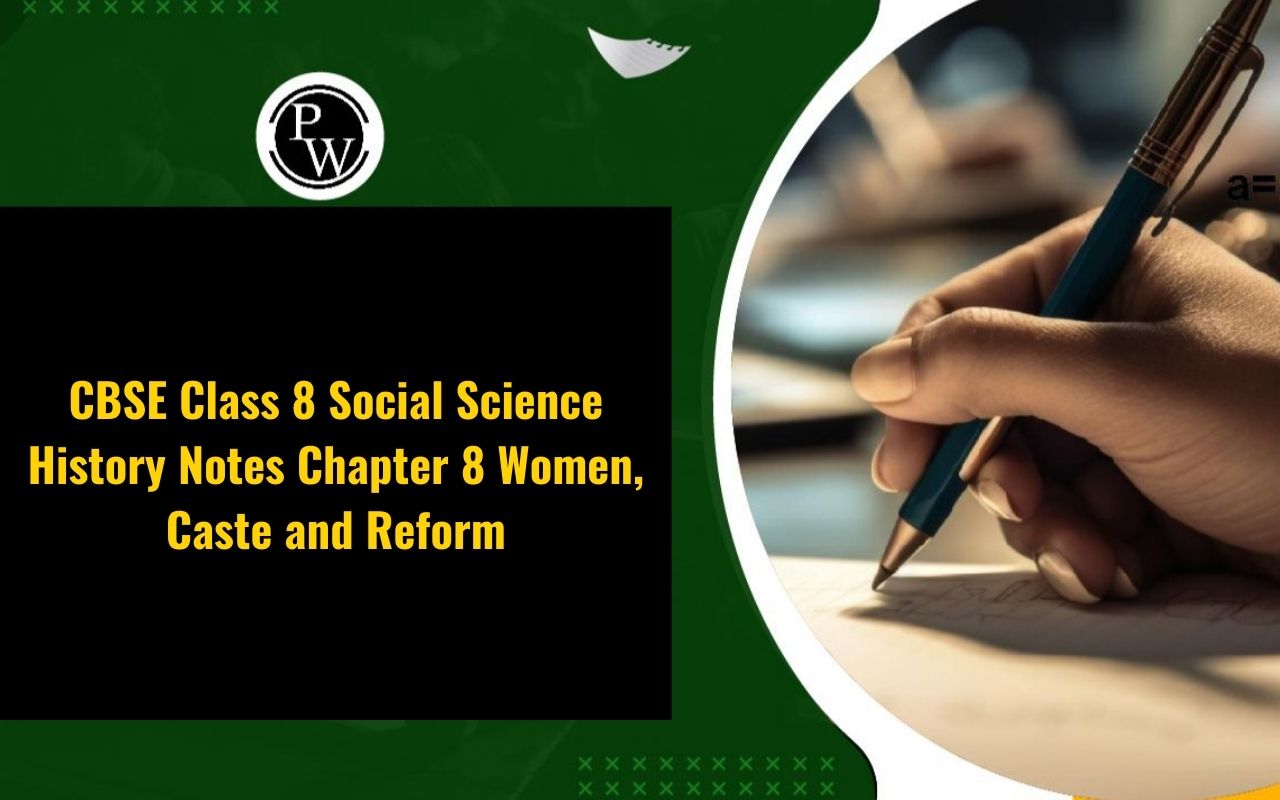

CBSE Class 8 Social Science History Notes Chapter 8: Chapter 8 of CBSE Class 8 Social Science History, titled Women, Caste, and Reform, explain the significant social reforms in 19th-century India aimed at addressing issues related to women and caste discrimination.
The chapter highlights the efforts of various social reformers who fought against prevailing practices like child marriage, sati, and the lack of women's education. Through these reforms the chapter emphasizes the role of education and legal changes in bringing about social transformation and creating a more just society.CBSE Class 8 Social Science History Notes Chapter 8 Overview
These notes for Chapter 8 of CBSE Class 8 Social Science History Women, Caste, and Reform are prepared by subject experts of Physics Wallah. These notes cover key reform movements, the contributions of prominent social reformers, and the impact of these changes on Indian society. This resource is invaluable for students aiming to grasp the historical context and significance of these social transformations.CBSE Class 8 Social Science History Notes Chapter 8 PDF Download
The detailed notes for Chapter 8 of CBSE Class 8 Social Science History are available in the PDF link provided below. These notes cover essential topics related to social reforms in 19th-century India, including the movements for women's rights and the fight against caste discrimination. Access the PDF through the link below to enhance your exam preparation and knowledge.CBSE Class 8 Social Science History Notes Chapter 8 PDF
CBSE Class 8 Social Science History Notes Chapter 8 Women, Caste and Reform
The notes for CBSE Class 8 Social Science History Chapter 8 Women, Caste, and Reform are important as they provide a detailed understanding of the significant social reform movements in 19th and 20th-century India. These notes highlight the efforts made by key reformers like Raja Rammohun Roy, Ishwarchandra Vidyasagar, Jyotirao Phule, and Dr. B.R. Ambedkar who played pivotal roles in challenging gender inequality and caste discrimination. They cover critical topics such as the abolition of harmful practices like sati, the promotion of widow remarriage, and the fight against untouchability. By studying these notes students can grasp the historical context of these reforms and appreciate the progress made in achieving social justice and equality in Indian society.Introduction
Gulamgiri
Jyotirao Phule , born in 1827, was a visionary social reformer who developed a profound critique of the caste system. He argued that the Brahmans, whom he considered Aryans, were foreigners who invaded and subjugated the indigenous people of the Indian subcontinent.
According to Phule, the upper castes had unjustly claimed land and power that did not rightfully belong to them. He believed that before the Aryan conquest, there was a golden age where warrior-peasants ruled the Maratha countryside with fairness and equity. Phule urged the Shudras and Ati Shudras, who were marginalized and oppressed, to unite and challenge caste-based discrimination. To advance this cause, he founded the Satyashodhak Samaj an organization committed to promoting caste equality. In 1873, Phule published his seminal work Gulamgiri (Slavery), which he dedicated to the American abolitionists who fought to end slavery. This book highlighted not only the struggles of the low castes in India but also expressed Phule's concern for the suffering of upper-caste women and the laboring class, reflecting his broader commitment to social justice and equality.Who could enter temples?
In 1927, Dr. B.R. Ambedkar initiated a temple entry movement that sought to challenge caste-based restrictions on temple access, particularly targeting the discrimination faced by Dalits, including the Mahar caste. This movement was met with strong resistance from Brahman priests, especially when Dalits used water from temple tanks, which was traditionally forbidden to them. Ambedkar led three major temple entry movements between 1927 and 1935, aiming to expose the deep-seated caste prejudices ingrained in society and to assert the rights of Dalits to worship.The Non-Brahman movement
Parallel to Ambedkar's efforts, the Non-Brahman movement emerged, driven by non-Brahman castes who had gained access to education, wealth, and influence. These groups argued that Brahmans were descendants of Aryan invaders who had subjugated the indigenous Dravidian populations of the South. E.V. Ramaswamy Naicker, also known as Periyar, was a prominent leader of this movement. He initially joined the Indian National Congress but left after observing that lower castes were discriminated against even within the party. Periyar went on to found the Self Respect Movement, advocating for the rights of untouchables and promoting the idea that they were the true preservers of the original Tamil and Dravidian culture, which had been suppressed by Brahmanical dominance. He was highly critical of Hindu scriptures like the Manusmriti, Bhagavad Gita, and Ramayana, arguing that these texts had been used to justify the superiority of Brahmans over lower castes and the subordination of women. These radical assertions led to significant debates and self-reflection among upper-caste nationalist leaders, while orthodox Hindu society responded by forming associations like the Sanatan Dharma Sabhas and Bharat Dharma Mahamandal. These organizations aimed to defend the caste hierarchy as an essential element of Hinduism, asserting that it was sanctioned by ancient scriptures.Benefits of CBSE Class 8 Social Science History Notes Chapter 8 Women, Caste and Reform
- Comprehensive Understanding : These notes provide a detailed overview of the social reforms related to women and caste during the 19th and 20th centuries helping students grasp the historical context and significance of these changes.
- Concise Summaries : The notes are structured to summarize key events, movements, and reformers, making it easier for students to review and retain essential information.
- Exam Preparation : By focusing on important points and concepts, these notes are an excellent resource for exam preparation, ensuring students can quickly revise and recall critical details.
- Enhanced Critical Thinking : The notes encourage students to think critically about the social issues and reforms of the time, fostering a deeper understanding of how these changes impact society today.
CBSE Class 8 Social Science History Notes Chapter 8 FAQs
Who were some key reformers mentioned in the chapter?
Key reformers include Raja Rammohun Roy, Ishwarchandra Vidyasagar, Jyotirao Phule, and Dr. B.R. Ambedkar. These individuals played significant roles in advocating for social changes that addressed issues related to women’s rights and caste discrimination.
What was Raja Rammohun Roy’s contribution to social reform?
Raja Rammohun Roy was a pioneer in the campaign against the practice of sati (the burning of widows) and was instrumental in its abolition in 1829. He also founded the Brahmo Samaj, which worked for the reform of Hindu society, including promoting women’s education and challenging caste-based discrimination.
How did Ishwarchandra Vidyasagar contribute to the reform of women’s rights?
Ishwarchandra Vidyasagar advocated for widow remarriage and played a key role in the passage of the Widow Remarriage Act of 1856. He also supported women’s education and worked tirelessly to improve the condition of widows in India.
What was the significance of Jyotirao Phule’s work in caste reform?
Jyotirao Phule founded the Satyashodhak Samaj to promote caste equality and social justice. He challenged the dominance of the Brahmins and worked towards the upliftment of the Shudras and Ati-Shudras, advocating for their rights and education.
How did Dr. B.R. Ambedkar contribute to the fight against caste discrimination?
Dr. B.R. Ambedkar was a prominent leader in the Dalit community and fought against caste discrimination. He led the temple entry movement, worked for the rights of the untouchables, and played a crucial role in drafting the Indian Constitution, which enshrines the principles of equality and justice.
Talk to a counsellorHave doubts? Our support team will be happy to assist you!

Check out these Related Articles
Free Learning Resources
PW Books
Notes (Class 10-12)
PW Study Materials
Notes (Class 6-9)
Ncert Solutions
Govt Exams
Class 6th to 12th Online Courses
Govt Job Exams Courses
UPSC Coaching
Defence Exam Coaching
Gate Exam Coaching
Other Exams
Know about Physics Wallah
Physics Wallah is an Indian edtech platform that provides accessible & comprehensive learning experiences to students from Class 6th to postgraduate level. We also provide extensive NCERT solutions, sample paper, NEET, JEE Mains, BITSAT previous year papers & more such resources to students. Physics Wallah also caters to over 3.5 million registered students and over 78 lakh+ Youtube subscribers with 4.8 rating on its app.
We Stand Out because
We provide students with intensive courses with India’s qualified & experienced faculties & mentors. PW strives to make the learning experience comprehensive and accessible for students of all sections of society. We believe in empowering every single student who couldn't dream of a good career in engineering and medical field earlier.
Our Key Focus Areas
Physics Wallah's main focus is to make the learning experience as economical as possible for all students. With our affordable courses like Lakshya, Udaan and Arjuna and many others, we have been able to provide a platform for lakhs of aspirants. From providing Chemistry, Maths, Physics formula to giving e-books of eminent authors like RD Sharma, RS Aggarwal and Lakhmir Singh, PW focuses on every single student's need for preparation.
What Makes Us Different
Physics Wallah strives to develop a comprehensive pedagogical structure for students, where they get a state-of-the-art learning experience with study material and resources. Apart from catering students preparing for JEE Mains and NEET, PW also provides study material for each state board like Uttar Pradesh, Bihar, and others
Copyright © 2025 Physicswallah Limited All rights reserved.
Get App










